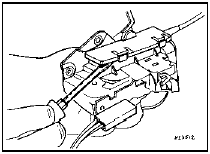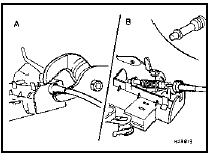Door lock - removal and refitting
Models up to 1990
1 Remove the door inner trim panel.
2 Where necessary for improved access, peel back the waterproof plastic sheet from the door.
3 Withdraw the window channel extension through the lower rear door aperture after removing the single securing screw if working on a front door or the two securing screws if working on a rear door.
4 Remove the three securing screws from the rear edge of the door, then reach inside the door and turn the lock to disconnect it from the control rods.
5 Where applicable, disconnect the “door ajar” sensor wiring plug and the central locking component wiring plug(s). Central locking component removal and refitting is covered in Chapter 13.
6 Withdraw the lock from inside the door.
7 Refitting is a reversal of removal, but ensure that the window channel extension is correctly located.
Models from 1990
8 From 1990, cable-operated door locks have
been fitted to all Sierra models. To remove the
later type of lock, proceed as follows. Do not
bend or stretch the cable during removal and
refitting, as the operation of the lock will be
impaired.
9 Remove the door inner trim panel.
10 Where necessary for improved access, peel back the waterproof plastic sheet from the door.
11 Remove the securing screw, and withdraw the window channel extension through the door’s lower aperture.
12 Disconnect the door outer handle and the lock barrel (front doors) operating rods at the lock assembly.
13 Disconnect the battery negative lead, and disconnect the door lock motor and the alarm system wiring plugs (where applicable).
14 Remove the screw securing the door interior handle to the door panel.
15 Remove the three lock securing screws from the rear edge of the door, then withdraw the lock assembly complete with the operating cable and the door interior handle.
16 To disconnect the cable from the lock, proceed as follows.
17 Carefully prise the cover plate from the lock, using a screwdriver (see illustration).

21.17 Prising the cover plate from a cableoperated door lock
18 Using a suitable pair of pliers, carefully remove the outer cable from the groove in the lock assembly casing.
19 Extend the inner cable until the flats on the plastic end piece align with the guide, then withdraw the cable (see illustration).

21.19 Disconnecting the operating cable from a cable-operated door lock
A Removing outer cable B Disconnecting inner cable
20 Commence reassembly and refitting as follows.
21 Align the flats on the inner cable end piece with the cable guide, and refit the inner cable.
22 Using a suitable pair of pliers, carefully refit the outer cable to the groove in the lock assembly casing.
23 Refit the lock cover plate.
24 Insert the lock, cable and interior handle into the door, and refit the three lock securing screws.
25 Push the interior handle assembly towards the lock to adjust the cable, and when adjustment is correct, refit and tighten the interior handle securing screw.
26 Further refitting is a reversal of removal, ensuring that the window channel extension is correctly located.
Door check arm - removal and refitting
Removal
1 Remove the door inner trim panel.
2 Unscrew and remove the bolt securing the check arm to the body pillar.
3 Unscrew and remove the two bolts securing the check arm to the door, and withdraw the check arm from inside the door.
Peel back the waterproof plastic sheet where necessary for improved access.
Refitting
4 Refitting is a reversal of removal.
See also:
Disc pads - inspection and renewal
Caution: Refer to the
precautions in Section 1.
Front disc pads
1 The disc pad friction material can be
inspected for wear without removing the
roadwheels. Working beneath the vehicle,
insert a ...
Specifications
General
System type . . . . . . . . . . . . . . . . . . . . . . . . . . . . . . . . . .
. . . . . . . . . . . . Bosch mechanical continuous injection system
Application:
XR3i and XR3i Cabriolet m ...
Weber 2V carburettor automatic choke unit - adjustment
XR3 models
1 Remove the air cleaner as described in
Section 2.
2 Disconnect the electrical lead to the
automatic choke.
3 Unscrew and remove the three screws
which hold the automatic choke housi ...
